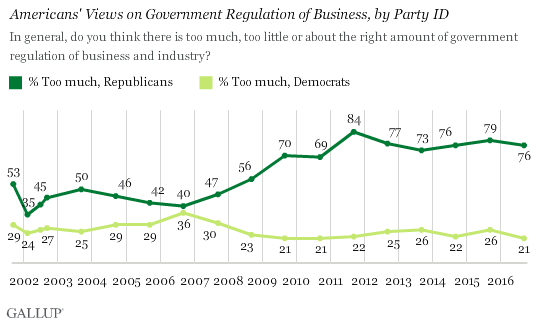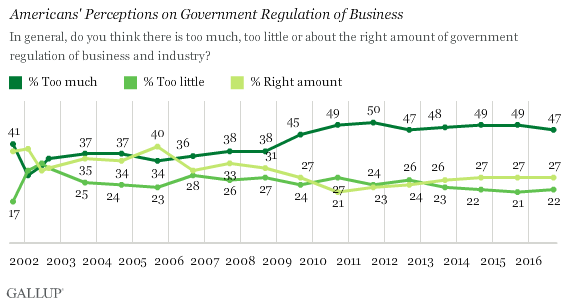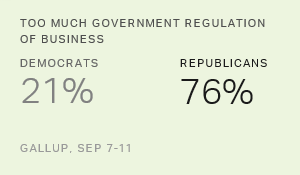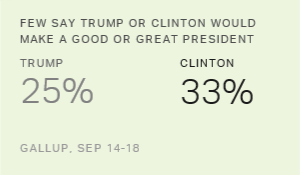Story Highlights
- About three in four Republicans say business regulations are too much
- One in five Democrats see too much regulation
- Attitudes shifted after Obama's election
WASHINGTON, D.C. -- Donald Trump's assertion at Monday night's presidential debate that he would cut regulations while Hillary Clinton would "increase regulations all over the place" is consistent with the sensitivity to government regulation of business among members of his party. Republicans (76%) are more than three times as likely as Democrats (21%) to say there is "too much" government regulation of business and industry. Since President Barack Obama took office in 2009, Republicans' and Democrats' views on the matter have been widely at odds.

For her part, Clinton claimed that her proposals would "cut regulations and streamline them for small businesses," but this may have been directed more at those outside of her party, as relatively few Democrats (21%) say there is too much government regulation. In fact, too much business regulation was not a major concern of Democrats even before Obama's presidency. Since 2002, the percentage saying there was too much regulation of business has been between 21% and 29% in all but two polls.
Democrats are currently more likely to say the government regulates business too little (35%) or about the right amount (39%).
Republicans have typically been more likely than Democrats to be concerned with too much business regulation, even during the administration of Republican President George W. Bush. The percentage of Republicans citing too much regulation ranged from 35% to 56% throughout Bush's presidency. This jumped to 70% at the start of Obama's first term in 2009 and reached an apex of 84% in 2011.
The latest results come from Gallup's Sept. 7-11 annual Governance poll. Overall, about half of U.S. adults (47%) believe that the government regulates business and industry too much. Meanwhile, 27% say there is about the right amount of government regulation, while the smallest segment, 22%, believe there is too little.

In line with the changes observed among Republicans and Democrats, Americans' views on business regulation shifted between the Bush and Obama administrations. Throughout the better part of Bush's two terms, the public was closely divided between saying there was too much versus about the right amount of government regulation of business and industry. Since Obama took office, close to half of the public has said there is too much regulation -- driven by the dramatic rise in this view among Republicans -- and the other half has split between saying there is about the right amount or too little.
Bottom Line
Americans' attitudes about government regulation of business and industry shifted when Obama became president, mainly because Republicans increasingly adopted the view that there was too much regulation. Those views would likely persist if Clinton is elected but could recalibrate if Trump wins.
Since 2009, Americans have been most likely to feel there is too much regulation, which could be related to the hundreds of regulations that went into effect on Obama's watch. Analysis by George Washington University's Regulatory Studies Center finds that Obama's regulations have outpaced those of the prior two presidents.
As Election Day nears, both major parties' candidates have made regulation-related pledges. But Republicans and Democrats do not share the same level of concern that government regulation is a problem.
Historical data are available in Gallup Analytics.
Survey Methods
Results for this Gallup poll are based on telephone interviews conducted Sept. 7-11, 2016, with a random sample of 1,020 adults, aged 18 and older, living in all 50 U.S. states and the District of Columbia. For results based on the total sample of national adults, the margin of sampling error is ±4 percentage points at the 95% confidence level. All reported margins of sampling error include computed design effects for weighting.
Each sample of national adults includes a minimum quota of 60% cellphone respondents and 40% landline respondents, with additional minimum quotas by time zone within region. Landline and cellular telephone numbers are selected using random-digit-dial methods.
View survey methodology, complete question responses and trends.
Learn more about how the Gallup Poll Social Series works.



